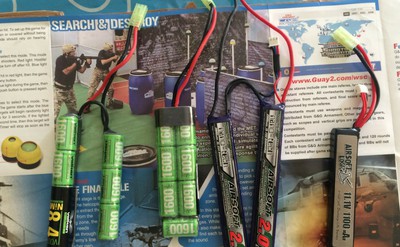You’ve probably wondered why the majority of the airsoft community is switching over from NiMH style batteries to LiPos. In fact, many guns these days, are branded with the term LiPo-Ready. With new technology being introduced to the sport, a good way to gain an advantage is to stay knowledgeable about the newest trends. Most airsoft players don’t know the advantages and benefits that come from using a LiPo. By reading this guide, you will be informed about Airsoft LiPo batteries and hopefully encouraged to make the switch from NiMH to LiPo.
Related Articles:
- Interest? Airsoft Guide For Beginners [Brands, Gear, Tech, Tactics,…]
- Get Creative! Top DIY Airsoft Mods [Modifications]
- Learn Your Gun! Airsoft for Firearms Training [Practice, Practice, Practice]
- Learn Something New! Guide to Air-Smithing [It’s Easy]
- Firepower! Guide to Airsoft FPS [Test Your Limits]
What is an Airsoft LiPo Battery?
A LiPo is a common battery type that all sorts of different hobbies use. It stands for Lithium-Polymer and provides more benefits than a usual NiMH battery. LiPos are smaller, more flexible, have more capacity and increases your guns trigger response. NiMHs, on the other hand, is another type of battery that stands for Nickel-Metal Hydride and used to be the mainstream battery that all airsoft players used.  In this day and age, it is fine to use NiMH’s but after being introduced to this new technology, why wouldn’t you switch? NiMHs are still being used to this day by beginners because often times, beginners tend to forget about their battery. If forgotten and discharged to 0%, a NiMH battery can be given life again by just charging it once more. There are disadvantages with these batteries as they are also much bigger and harder to fit inside compact weapon types.
In this day and age, it is fine to use NiMH’s but after being introduced to this new technology, why wouldn’t you switch? NiMHs are still being used to this day by beginners because often times, beginners tend to forget about their battery. If forgotten and discharged to 0%, a NiMH battery can be given life again by just charging it once more. There are disadvantages with these batteries as they are also much bigger and harder to fit inside compact weapon types.
One of the biggest disadvantages of using a LiPO is the fact that once it is discharged or falls below a certain voltage threshold, it cannot be used again. This is why it is not advised for beginners to use LiPos immediately rather than a NiMH. If you are able to handle this disadvantage, you will reap the benefits of a LiPo and see what the big deal is all about.
Are LiPO Batteries Worth It?
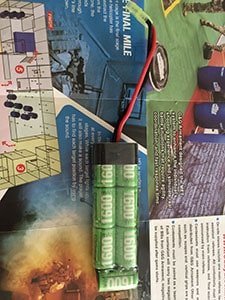 Short answer, yes. You should get a LiPo because they are compact, smaller and easier to fit in your gun. We all know the struggle of trying to stuff the wires in the battery compartment due to the small space provided but struggle no more! LiPos are smaller, flexible and will provide the same or more (depending on what battery) voltage that you desire. Despite the small size of a LiPo, they can hold more charge (measured in maH) when compared to its NiMH counterpart. This means that using a LiPo will allow you to stay in battle longer without having to go back and charge it again. Regarding the price of a LiPo, they are much cheaper than a NiMH and can even be as cheap as six dollars. They are extremely cost-efficient and won’t hurt your budget when entering the sport. This also means that you can get more in case one breaks down, so you’ll be more prepared when going to your local field.
Short answer, yes. You should get a LiPo because they are compact, smaller and easier to fit in your gun. We all know the struggle of trying to stuff the wires in the battery compartment due to the small space provided but struggle no more! LiPos are smaller, flexible and will provide the same or more (depending on what battery) voltage that you desire. Despite the small size of a LiPo, they can hold more charge (measured in maH) when compared to its NiMH counterpart. This means that using a LiPo will allow you to stay in battle longer without having to go back and charge it again. Regarding the price of a LiPo, they are much cheaper than a NiMH and can even be as cheap as six dollars. They are extremely cost-efficient and won’t hurt your budget when entering the sport. This also means that you can get more in case one breaks down, so you’ll be more prepared when going to your local field.
LiPos will run better and give you better trigger response on your gun. They will allow you to have a more consistent ROF (Rate of Fire) and give you a performance boost on the field. If you are scared about the concept of discharging your battery and balancing it out, you do not have to worry since a lot of smart chargers can rid you of this hassle. This means that you won’t have to deal with your battery dying mid fight and your battery will be fine.
How to Maintain a LiPo Battery
 LiPo’s won’t need much maintenance if you carefully look after it. What you need first is a smart-charger which is used to charge and stop when the battery is full. You should also get a smart-charger that has the ability to balance the cells. Balancing issues usually concerns the 11.1v (3 Cell) LiPo because when the battery is discharged, there is a chance that there might be a cause of imbalance in voltage levels. You don’t have to worry about this if you have a balance charger that can check your voltage and balance them out when necessary.
LiPo’s won’t need much maintenance if you carefully look after it. What you need first is a smart-charger which is used to charge and stop when the battery is full. You should also get a smart-charger that has the ability to balance the cells. Balancing issues usually concerns the 11.1v (3 Cell) LiPo because when the battery is discharged, there is a chance that there might be a cause of imbalance in voltage levels. You don’t have to worry about this if you have a balance charger that can check your voltage and balance them out when necessary.
If you want to store your LiPo, you should charge or discharge it so that each cell contains 3.8V per cell. You also have the option of storing it fully charged but after doing additional research, this can damage the battery’s life. Storing the batteries when it’s nearly empty is also a bad idea because LiPos self-discharge which means that they can drop below a voltage threshold and that cell will not be usable. For future reference, try not to discharge your battery below 3.0 V.
 All you need to do to store your LiPo is to keep the voltage of each cell to 3.8V (Nominal). Discharging it and maintaining this voltage for storage will keep your LiPo strong and durable. If you are scared of your cells dropping too low, you can purchase a LiPo voltage alarm that connects to your battery and is also inexpensive. It goes for around 2$ and can save your battery from a potential disaster. Some smart-chargers come with this function, so check your purchases before spending that 2$. The product recommended is a slimmer battery alarm that can fit in your stock but a little more expensive than the usual LiPo alarm. Since it can be equipped during your field playing time, once you hear a beeping noise, you’ll be alerted that your LiPo needs to be taken out. Check out this LiPo Micro Battery tester!
All you need to do to store your LiPo is to keep the voltage of each cell to 3.8V (Nominal). Discharging it and maintaining this voltage for storage will keep your LiPo strong and durable. If you are scared of your cells dropping too low, you can purchase a LiPo voltage alarm that connects to your battery and is also inexpensive. It goes for around 2$ and can save your battery from a potential disaster. Some smart-chargers come with this function, so check your purchases before spending that 2$. The product recommended is a slimmer battery alarm that can fit in your stock but a little more expensive than the usual LiPo alarm. Since it can be equipped during your field playing time, once you hear a beeping noise, you’ll be alerted that your LiPo needs to be taken out. Check out this LiPo Micro Battery tester!
If you think your LiPo is about to explode, or that it’s bigger than usual(inflated), you don’t have to worry. This means that your battery is dead but IF you continue to use it, it can actually catch fire. Normally, you should not ever have to experience this but if you do, remove the battery, and put it in a LiPo-safe container. Afterward, safely dispose of the LiPo and purchase another.
Things to Look For in a LiPo Battery
You probably don’t want to spend thousands of dollars on just the battery. You want something cheap, effective and reliable. Luckily, LiPos are very cheap but the main part of your budget should go to the equipment used to maintain it. You want a quality smart-charger and a LiPo voltage alarm. This will make sure that you will not have to deal with any of the problems that come with your battery.
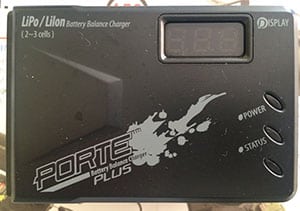 The smart-charger is probably the essential thing to a LiPo. You can get a high-quality LiPo Charger for relatively cheap and it can save you A LOT of hassle. The product recommended can charge your LiPo and will automatically stop when its full. This means that it will never overcharge so that your LiPo will be safe. If you have an 11.1v LiPo battery, you might want to consider getting the balance charger as 11.1v batteries are prone to cell imbalance. Check out this smart charger or this balance charger!
The smart-charger is probably the essential thing to a LiPo. You can get a high-quality LiPo Charger for relatively cheap and it can save you A LOT of hassle. The product recommended can charge your LiPo and will automatically stop when its full. This means that it will never overcharge so that your LiPo will be safe. If you have an 11.1v LiPo battery, you might want to consider getting the balance charger as 11.1v batteries are prone to cell imbalance. Check out this smart charger or this balance charger!
Since you are looking for a new battery, you should know that Tenergy is a great brand to look for. You don’t want any rebranded crap so try to look for a Tenergy Battery that will fit in your battery compartment. There are two products following this paragraph that can fit your battery compartment. One is a nunchuck style battery usually fitting in crane-style stocks and another is a stick battery which is small enough to fit in any gun. Check out this buffer tube stick battery or this crane stock batter!
More Related Articles:
- The More You Know! Airsoft History [Learn]
- What’s Inside? Guide to Airsoft Gear Boxes [Keep it Clean!]
- What’s Different? Types of Airsoft Magazines [Choices!]
- Fix it? Airsoft Tech Know Your Equipment [Yes We Can]
- Common Guidelines! Airsoft Safety [Equipment Suggestions]
Important Terminology
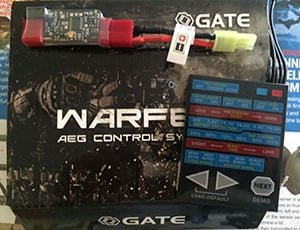 When browsing the site, you’ve probably noticed words like mAH, discharge, etc. The goal of this section is to inform you of the important terminologies used so that you can get the perfect battery for your gun. The most important thing that you should know is voltage. There are two main types of voltage levels for LiPos. They are 7.4v and 11.1v. One LiPo cell is 3.8v, so if you have two cells, you’ll have a 7.4v battery; if you have three, then you’ll have an 11.1v battery. Normally, a 7.4v is the goto battery since an 11.1v battery might be too strong for your gun. If your gun does not have a mosfet, an 11.1v battery can risk destroying your trigger contacts. So to be safe, I recommend getting a 7.4v battery unless you are sure your gun can handle it or contains a mosfet.
When browsing the site, you’ve probably noticed words like mAH, discharge, etc. The goal of this section is to inform you of the important terminologies used so that you can get the perfect battery for your gun. The most important thing that you should know is voltage. There are two main types of voltage levels for LiPos. They are 7.4v and 11.1v. One LiPo cell is 3.8v, so if you have two cells, you’ll have a 7.4v battery; if you have three, then you’ll have an 11.1v battery. Normally, a 7.4v is the goto battery since an 11.1v battery might be too strong for your gun. If your gun does not have a mosfet, an 11.1v battery can risk destroying your trigger contacts. So to be safe, I recommend getting a 7.4v battery unless you are sure your gun can handle it or contains a mosfet.
The next term is cells. LiPo’s have a varying number of cells which holds the charge. Like I’ve said about, there are two main types which refer to the two cell or three cell counterpart. A higher cell gun would mean more voltage but it would also mean an increase in size. When checking your LiPo with a LiPo checker, you’ll see that cells are denoted by an S or 5. Then it’ll tell you how many cells you have so that you can know if one is dead or not. Next, you’ll want to know how much space/capacity that your battery has. This is how much juice you’ll bring into the battlefield. The higher your mAh, the longer the battery can run. This also means that your battery size would increase. This means that you’ll have to make sure what the best mAh is so that you can fit the perfect battery in your gun.
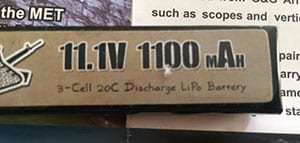 When researching about LiPo’s, it is common to notice the advertised C rating. This is the discharge rating and it is a measure of how fast the battery discharges safely. It is useful because you’ll know that you will need to stick with and not discharge higher than the number that is advertised.
When researching about LiPo’s, it is common to notice the advertised C rating. This is the discharge rating and it is a measure of how fast the battery discharges safely. It is useful because you’ll know that you will need to stick with and not discharge higher than the number that is advertised.
- 1000mAh = 1 Amps.
- 1 Amps * 15 = 15 Amps of continuous discharge.
Therefore, this means your gun can use 15 amps from your LiPo without damaging your battery. Having a higher C-rating would cycle your gearbox faster which results in a faster trigger response. A lower C-rating would just be slower. Keep in mind that a higher C-rating is not always better as it will add extra wear to your gears.
What is LiPo-Ready?
 LiPo-Ready is simply a marketing term used so that consumers unfamiliar with LiPo terminology would be inclined to buy it. A 7.4V battery would be fine in almost all AEG’s. An 11.1v, on the other hand, would require the gun to be modified or equipped with a mosfet so that your trigger contacts won’t get destroyed.
LiPo-Ready is simply a marketing term used so that consumers unfamiliar with LiPo terminology would be inclined to buy it. A 7.4V battery would be fine in almost all AEG’s. An 11.1v, on the other hand, would require the gun to be modified or equipped with a mosfet so that your trigger contacts won’t get destroyed.
If you do use an 11.1V battery on your gun without preparing, note that your entire gearbox will cycle faster which means there will be more wear and tear on your motor, your trigger contacts might be fried and there is a possibility that your piston could strip. This is why a lot of companies in airsoft are starting to implement built-in mosfets when assembling and creating a gun. For example, the introduction of the Ares Amoeba has a built-in mosfet which allows it to handle the stress of an 11.1v LiPo battery. Due to the popularity of a LiPo, the manufacturer knows that in order to increase sales, they must make guns that are able to handle an 11.1V battery. Another reminder to you, that a 7.4V LiPo can be safely used in almost all guns and also provide you with the advantages a LiPo would come with.
Myths and Misconceptions
 There are three reasons that I could think of on why airsoft players might be scared to make the switch over from NiMH to LiPo. They think that LiPo’s are dangerous, require tons of maintenance and can only be used in certain guns. This is wrong. LiPo’s do not require a lot of maintenance. This does not mean you can neglect them but they require simple maintenance that will take a second of your time. All you really need to do with a LiPo is make sure the voltage levels are full when you are using it, and that it does not discharge under 3.0V. If you have an alarm connected to your battery, then you’ll be alerted so that is another hassle gone. With new technology coming out like smart-chargers, balancers, alarms, etc. All the annoying types of hassle has been nearly eliminated.
There are three reasons that I could think of on why airsoft players might be scared to make the switch over from NiMH to LiPo. They think that LiPo’s are dangerous, require tons of maintenance and can only be used in certain guns. This is wrong. LiPo’s do not require a lot of maintenance. This does not mean you can neglect them but they require simple maintenance that will take a second of your time. All you really need to do with a LiPo is make sure the voltage levels are full when you are using it, and that it does not discharge under 3.0V. If you have an alarm connected to your battery, then you’ll be alerted so that is another hassle gone. With new technology coming out like smart-chargers, balancers, alarms, etc. All the annoying types of hassle has been nearly eliminated.
Secondly, airsoft players are scared that they need LiPo storage bags since there had been rumors of LiPos catching on fire. LiPos only catch on fire if and only if you use it the way it has not been intended. Just make sure your LiPo is not used when it is puffy or inflated(dead) and that you are using it the way it has been advertised. The last myth is a yes and no. It is true that LiPos require modification and/or a mosfet to use but a 7.4V LiPo can be used in any gun (without a mosfet). I would say that you would only get an 11.1v battery if your gun contains a mosfet. If not, I would use a 7.4 V LiPo and reap the benefits that using a LiPo has.
Guide to Airsoft Li-Po Batteries Final Thoughts
LiPos are a great and quick way to gain an advantage on the battlefield. Fast trigger response is key and with larger capacities than a NiMH, you’ll be able to stay in battle longer. Don’t be afraid of maintaining your LiPo, or scared that it’ll bring tons of hassle to your sport. As long as you take care of your LiPo and treat it well, it in return, will do the same. All in all, LiPos will run reliably for a long time and reward you for treating it well. Thank you for visiting iamairsoft.com! For great products and more information about the game, check out our Airsoft Buyers Guides and Airsoft U!
Even More Related Articles:
- Boom! How do Airsoft Grenades Work? [How to Use Them]
- This or That? Airsoft vs. BBSs [Know the Difference]
- It’s All Important! Airsoft BB Weight [Everything BBs]
- Enhance Your Experience! CO2 vs Green Gas [Get blowback…]
- Question: Does Airsoft Hurt? Airsoft vs Paintball Pain [Ouch!]
- Did That Bush Move? BDU vs. ACU [The Differences Explained]
- Airsoft Laws: Are Airsoft Guns Legal in Your State?

Henry grew up in Toronto, Canada where he did the basic stuff children do. He has a passion in Airsoft and loves to introduce others to the sport. He currently studies at York University and plays mostly at Siege Airsoft.

